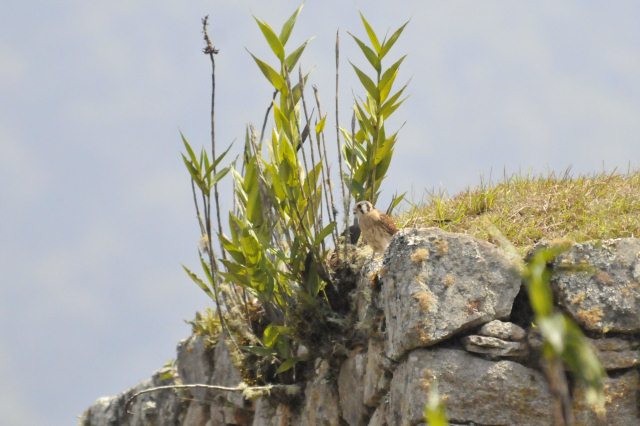The American Kestrel

|
American Kestrel
The American kestrel (Falco sparverius), sometimes colloquially known as the Sparrow Hawk, is a small falcon found in the Western Hemisphere. It is the most common falcon in North America, it can live in a wide variety of habitats. It hunts by hovering in the air with rapid wing beats or perching and scanning the ground for prey. Its diet typically consists of creatures such as grasshoppers, lizards, mice and other small birds.
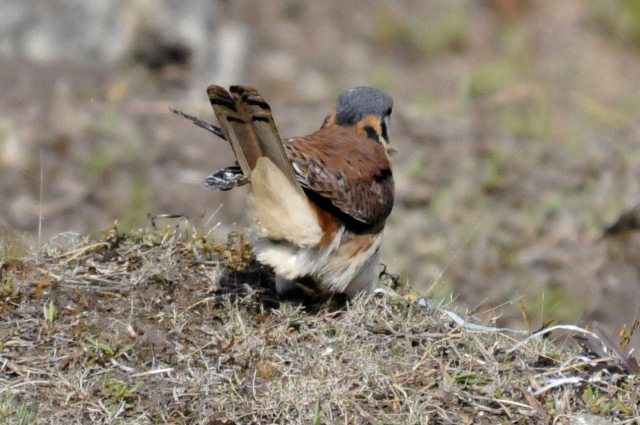
Then watched as he leapt on something tasty Description: The American kestrel is the smallest falcon in North America - about
the size of a large thrush. The bird is about seven to eight inches long and has a wingspan
twenty to twenty four inches, with the female typically larger than the male.
The male can weigh three point six to four point two ounces, and the female four
point four to five point nine ounces. Plumage has more variation between the
sexes. Males have blue-grey wings with black spots, while the undersides are white with black barring.
The back is rufous, with barring on the lower half. The belly and flanks are white with
black spotting. The tail is also rufous, with a white or rufous tip and a black
subterminal band. The back and wings of the female American kestrel are rufous with
dark brown barring. The undersides of the females are creamy to buff with heavy brown streaking. The tail is noticeably different from
the males, being rufous in colour with numerous narrow dark black bars.
Juveniles exhibit coloration patterns similar to the adults. In both sexes, the
head is white with a bluish-grey top. There are also two narrow, vertical black
facial markings on each side of the head, while other falcons have one. Two
black spots (ocelli) can be found on each side of the white or orangish nape.
These spots act as "false eyes", and probably help to protect the bird from
potential attackers, though they may aid in catching prey as well. The wings are
moderately long, fairly narrow, and taper to a point. While perched, the
wingtips are noticeably shorter than the tail tip. Vocalisations: The American kestrel has three basic vocalizations – the "klee" or
"killy", the "whine", and the "chitter." The "klee" is usually delivered as a
rapid series – klee, klee, klee,
klee when the kestrel is upset or excited. This call used in a wide
variety of situations and is heard from both sexes, but the larger females
typically have lower-pitched voices than the males. The "whine" call is
primarily associated with feeding, but is also used in copulation. The "chitter" is used in activities which involve interaction
between male and female birds, including courtship feeding, copulation, and the
feeding of nestlings. Nestlings can
produce calls similar to those of adults at 16 days old. Systematics: Until the sixth edition of the AOU Checklist of North American Birds was published by the American Ornithologists' Union in 1983, the most commonly used name for the American Kestrel was the Sparrow Hawk or Sparrow hawk. This was due to a mistaken connection with the Eurasian Sparrow hawk in the genus accipiter. The sixth edition of the AOU Checklist corrected this, officially renaming the bird American kestrel. Several other local names for the kestrel are also in use, including Grasshopper Hawk, due to its diet, and Killy Hawk, due to its distinct call. The American kestrel’s scientific name was given by Carolus Linnaeus in his 18th Century work Systema Naturae under the name Falco sparverius. The genus refers to the falcate, or hooked, shape of the beak, and the species name means "pertaining to a sparrow", referring to the bird's small size and occasional hunting of sparrows. Seventeen subspecies of the American kestrel are recognised, generally based upon plumage, size, and vocalizations: F. s. peruvianus (Cory, 1915) is found in southwest Ecuador, Peru, and northern Chile.
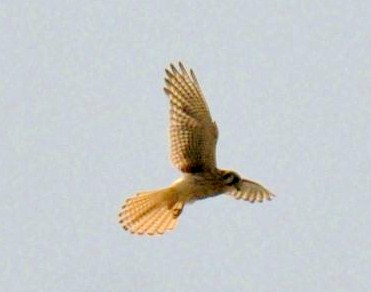
Soaring high above us Ecology and behaviour: American kestrels are found in a wide variety of habitats, including
grasslands, meadows, deserts, and other open to semiopen regions. They can also be found in both
urban and suburban areas. Requirements for a kestrel's habitat include open
space for hunting, perches, and cavities for nesting (whether they are natural
or man-made). The American kestrel is also able to live in very diverse
conditions, including elevations of over fourteen thousand feet in the Andes of
South America. Its distribution ranges from northern Canada and Alaska, down to
the southernmost tip of South America, Tierra
del Fuego. American kestrels in Canada and the northern United States
typically migrate south in the winter, sometimes going as far as Central America
and the Caribbean. Birds that breed south of about thirty five degrees north
latitude are usually year-round residents. Migration also depends on local
weather conditions. There is often is a sex difference in wintering kestrels'
selection of habitat. Females are usually found in open areas more often than
males during the non-breeding season. Explanations for this behavior include the
two sexes utilizing their habitats differently, or the larger females arriving
to the preferred habitat first and excluding males from their territory.
The American kestrel is not long-lived, having an average lifespan of
five years. The oldest banded wild bird was eleven years and seven months old,
and the oldest captive kestrel was a fourteen year old male house pet. The
kestrel has an average mortality
rate of fifty seven per cent. In a study, humans accounted for nearly
half of the 1,355 reported deaths, which included direct killing and road kills,
while predation accounted for around three per cent. Feeding: American Kestrels feed largely on small creatures such as grasshoppers, dragonflies, lizards, mice, and voles. They will also eat other small birds. The Kestrel has also been reported to have killed larger animals such as snakes, bats, and squirrels. Part of the reason the Kestrel maintains high population densities is because it can eat a wide variety of both insects and vertebrates. The American kestrel’s primary mode of hunting is by perching and waiting for prey to come near. The bird is characteristically seen along roadsides or fields perching from objects such as trees, telephone wires, or fence posts. It also hunts by hovering in the air with rapid wing beats and scanning the ground for prey. Other hunting techniques include low flight over fields, or chasing insects in the air. Prey is almost always caught on the ground. Before striking, the kestrel characteristically bobs its head and tail, and then makes a direct flight toward the prey to grab it in its talons. During the breeding season, the bird will carry large prey back to his or her mate or young. An American kestrel pair "foraged in ways that minimized the costs of energy acquisition in its particular situation" according to one study. For example, if a particular area falls below the average success rate for capturing prey, the bird will move to a different area.
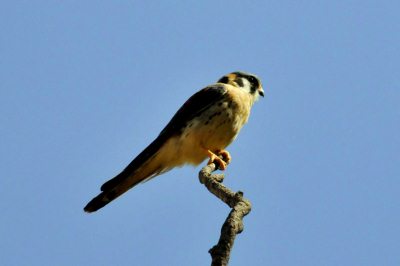 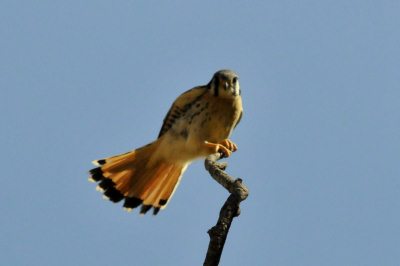
We saw this little girl sitting in the sun when we went for a wander at the back of the Royal Inka Hotel in Pisaq Reproduction: American Kestrels form pairs in which the bond is strong, tending
toward permanence. Returning migrants commonly re-establish territories held the
previous year. In one study, a pair nested in the same tree for six consecutive
years. Nesting occurs from late spring to late summer in North America, with
incubation underway by the end of May; in tropical South
America the birds breed roughly from June onwards through to September.
Courtship begins shortly after the male establishes a territory. In early
courtship, he may give the "dive display", a series of climbs and dives thirty
to sixty feet with three to five "klee" notes given near the peak of each climb.
He may present the female with food during courtship feeding. He may entice her
to the nest site by calling. He may "flutter-glide" toward her with quick and
shallow wing beats while carrying food and she may also beg for food by
flutter-gliding. The female initiates copulation by bowing with her tail in line
with her body or slightly raised. A cavity nester, American kestrels will use holes in trees, rock
cavities and crevices in cliffs, artificial nest boxes, or small spaces in
buildings. The number of suitable breeding cavities limits this species'
breeding density. The American kestrel has adapted well to nest boxes. In one
program, nest boxes were fixed to the backs of signs along a freeway thus
allowing kestrels to breed in areas formerly devoid of nest sites. Pairs nesting
in boxes on poles have much higher nesting success than pairs using boxes on
trees. Both sexes take turns incubating their eggs, a very rare situation among North American birds of prey where the
female usually incubates exclusively. Correspondingly, both sexes develop bare oval patches
on each side of their breasts where the warm bare skin can contact the eggs for
warming. There are from three to seven eggs per clutch, but four to six are average. They hatch twenty nine to thirty one
days after being laid. The eggs are typically elliptical in shape, and are white
or pinkish-white with an even covering of fine spots and flecks of brown shades,
occasionally concentrating as a ring or a cap. The young grow very quickly, becoming noisy between day eleven and
fourteen and assuming adult weight in about two and a half weeks. The young
fledge in thirty days. Early fledgling behavior varies. Broods typically stay
together for a week or two. Some broods remain close to the nest area for a week
or two while others travel throughout the parents' home range. Young disperse
permanently away from the nest area at about twenty five days after fledging.
Young disperse as hunting skills develop. Occasionally groups of older juveniles
from various broods join together into flocks. The American kestrel can raise
two broods per year, notably in areas with abundant small mammals e.g. in the
southern United States. Replacement clutches can be laid. Status and conservation: As this bird occurs over a wide range and is not generally rare, the
IUCN classifies it as a Species of Least
Concern. Local populations may fluctuate according to resource availability,
and birds may become locally extinct if habitat deteriorates. The American kestrel’s North
American population has been estimated at one point two million pairs, with
the Central and South
American populations being as large. The south eastern race, Falco sparverius paulus, is in
serious decline (an 82 percent decrease since the early 1940’s in north central
Florida) possibly due to habitat loss and loss of nest sites, and has been
listed in Florida as "threatened". Threats to the species as a whole include
loss of nest sites, pesticide poisoning (dieldrin
and DDT, among others), and death through collisions with vehicles as well
as shooting. Use in falconry: American kestrels (along with the Red-tailed Hawk) are one of two raptors almost universally used by apprentice falconers in the US. This is largely due to federal laws restricting apprentices. The American kestrel is generally considered to be a harder bird to care for due to its small size, quick metabolism and fragile nature (in comparison with the much larger Red-tail and other raptors) and requires extensive weight management, often within a couple of tenths of a gram. Falconers typically use American kestrels to hunt non-game species: insects, sparrows, starlings and grackles. Male American kestrels, due to their smaller size, are best suited for sparrows and starlings - though particularly skilled and competent males may occasionally tackle grackles. The larger females are slightly less agile than the males but can take larger prey. Hunting kestrels are at risk of predation by cats, dogs and other raptors, in particular Cooper's Hawk. Behaviorally, kestrels generally tame down relatively quickly in comparison to other raptors, usually in one to three weeks. This tameness helps considerably in day-to-day care, as Kestrels used in falconry should be kept indoors in order to better control weight and protect the bird from predation. The downside of this tameness is the American Kestrel's penchant to begin "screaming" (food begging) – incessant, piercing, loud calls - whenever the falconer appears. Not for keeping on Beez Neez.
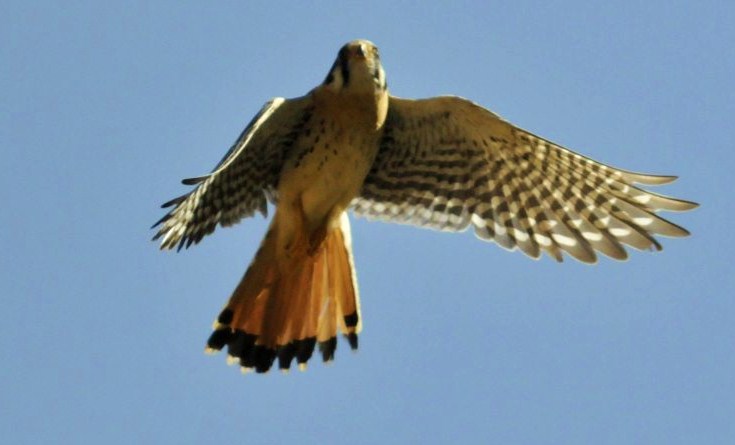
ALL IN ALL A BEAUTIFUL LITTLE
BIRD |
